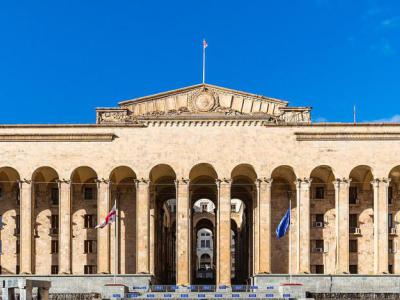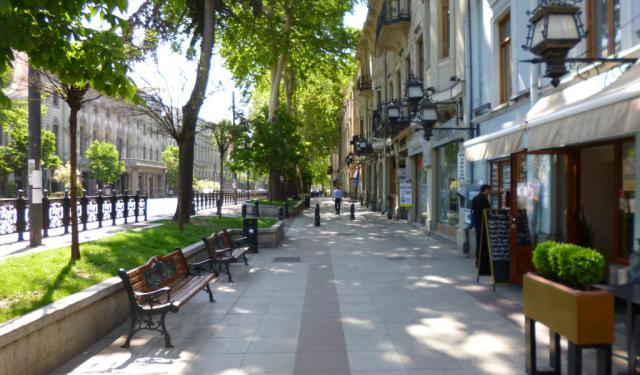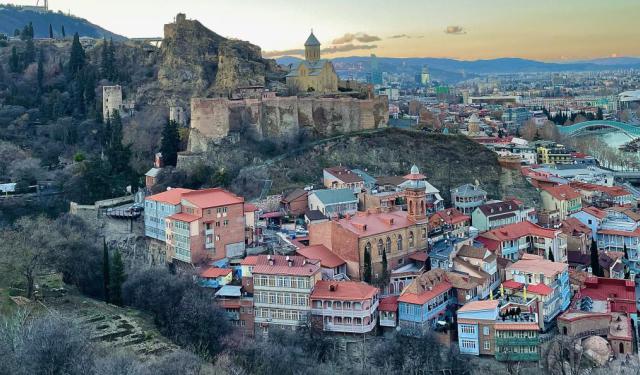
Georgian Parliament Building, Tbilisi
The Parliament of Georgia Building is where the members of the Parliament of Georgia gather in Tbilisi. It is situated on Rustaveli Avenue, close to the base of Mount Mtatsminda.
The building complex was originally constructed as the House of Government of Georgian SSR on the site of the Alexander Nevsky Cathedral. The cathedral, adjacent churchyard, and the graves of Georgian cadets who died in the Bolshevik invasion in 1921 were demolished. The Parliament Building consists of two structures. The "upper" building was designed by Viktor Kokorin and Giorgi Lezhava and built between 1933 and 1938. The "lower" building, facing Rustaveli Avenue, was constructed by the same architects with input from Vladimer Nasaridze between 1946 and 1953.
The buildings are connected by a courtyard with staircases and fountains. They incorporate elements of traditional Georgian architecture, with a notable grand arcade, imposing eaves, and an arched pediment facing the avenue. The buildings are made of lightweight reinforced concrete, with tufa rock, granite, and other materials used for the exterior cladding.
The complex was damaged during the 1991-1992 military coup. President Gamsakhurdia took shelter in an underground bunker. Later, the building was restored and became the Parliament seat from 1997 to 2012. A new Parliament building was then constructed in Kutaisi. In 2014, committee meetings were held in Tbilisi, while sessions took place in Kutaisi. However, a 2017 amendment removed Kutaisi as the Parliament seat. Thus, the Parliament fully returned to the capital in January 2019.
The building complex was originally constructed as the House of Government of Georgian SSR on the site of the Alexander Nevsky Cathedral. The cathedral, adjacent churchyard, and the graves of Georgian cadets who died in the Bolshevik invasion in 1921 were demolished. The Parliament Building consists of two structures. The "upper" building was designed by Viktor Kokorin and Giorgi Lezhava and built between 1933 and 1938. The "lower" building, facing Rustaveli Avenue, was constructed by the same architects with input from Vladimer Nasaridze between 1946 and 1953.
The buildings are connected by a courtyard with staircases and fountains. They incorporate elements of traditional Georgian architecture, with a notable grand arcade, imposing eaves, and an arched pediment facing the avenue. The buildings are made of lightweight reinforced concrete, with tufa rock, granite, and other materials used for the exterior cladding.
The complex was damaged during the 1991-1992 military coup. President Gamsakhurdia took shelter in an underground bunker. Later, the building was restored and became the Parliament seat from 1997 to 2012. A new Parliament building was then constructed in Kutaisi. In 2014, committee meetings were held in Tbilisi, while sessions took place in Kutaisi. However, a 2017 amendment removed Kutaisi as the Parliament seat. Thus, the Parliament fully returned to the capital in January 2019.
Want to visit this sight? Check out these Self-Guided Walking Tours in Tbilisi. Alternatively, you can download the mobile app "GPSmyCity: Walks in 1K+ Cities" from Apple App Store or Google Play Store. The app turns your mobile device to a personal tour guide and it works offline, so no data plan is needed when traveling abroad.
Georgian Parliament Building on Map
Sight Name: Georgian Parliament Building
Sight Location: Tbilisi, Georgia (See walking tours in Tbilisi)
Sight Type: Attraction/Landmark
Guide(s) Containing This Sight:
Sight Location: Tbilisi, Georgia (See walking tours in Tbilisi)
Sight Type: Attraction/Landmark
Guide(s) Containing This Sight:
Walking Tours in Tbilisi, Georgia
Create Your Own Walk in Tbilisi
Creating your own self-guided walk in Tbilisi is easy and fun. Choose the city attractions that you want to see and a walk route map will be created just for you. You can even set your hotel as the start point of the walk.
Rustaveli Avenue Walking Tour
If Tbilisi is the heart of Georgia, then Rustaveli Avenue is its pulse. As the capital's main artery, the importance – historical, cultural, or architectural – of this vibrant and bustling thoroughfare is hard to overestimate.
Named after the renowned medieval Georgian poet Shota Rustaveli, the avenue starts from Freedom Square – a key downtown landmark, home to the iconic statue of... view more
Tour Duration: 2 Hour(s)
Travel Distance: 2.5 Km or 1.6 Miles
Named after the renowned medieval Georgian poet Shota Rustaveli, the avenue starts from Freedom Square – a key downtown landmark, home to the iconic statue of... view more
Tour Duration: 2 Hour(s)
Travel Distance: 2.5 Km or 1.6 Miles
Tbilisi Introduction Walking Tour
A gateway to Georgia straddling the Mtkvari (Kura) River, the country's capital Tbilisi is one of the most historic cities in the Caucasus region, dating back over a thousand years. It was founded in the 5th century AD by the monarch of Iberia (Georgia's ancient precursor), King Vakhtang I Gorgasali.
According to legend, the king's falcon found the hot springs, near which the... view more
Tour Duration: 2 Hour(s)
Travel Distance: 3.8 Km or 2.4 Miles
According to legend, the king's falcon found the hot springs, near which the... view more
Tour Duration: 2 Hour(s)
Travel Distance: 3.8 Km or 2.4 Miles


